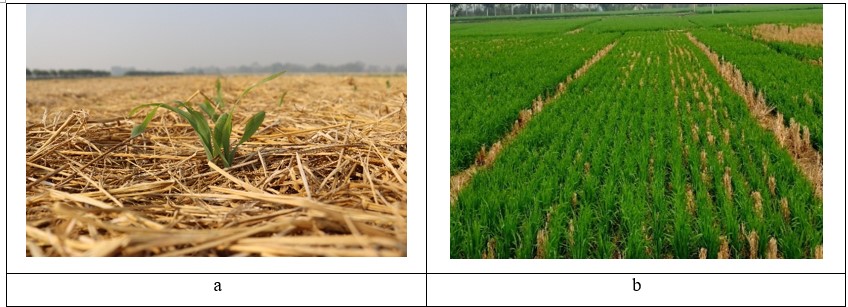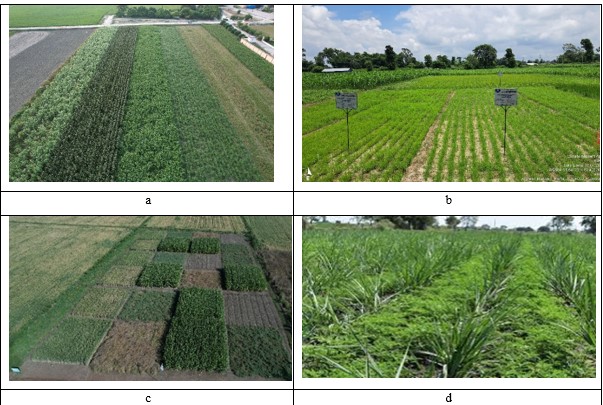CONSERVATION AGRICULTURE FOR SUSTAINABILITY, FOOD AND NUTRITION SECURITY IN A CHANGING CLIMATE
Authored By
Dr. S. Pazhanisamy, Dr. R.K. Jat, Dr. Shubham Durgude, Subhayan Das, Pankaj Kumar and Mahesh Maske
Agriculture faces significant challenges like climate change, soil degradation, and resource depletion. These challenges highlight the issues with conventional practices like intensive tillage and mono-cropping, which degrade soil fertility and threaten food security. One of the primary challenges of the present time is of feeding a growing and increasingly affluent world population (9.8 billion by 2050) with reduced external inputs and minimal environmental impacts. With national partners, BISA is implementing the Climate Resilient Agriculture Programs, covering about 251,000 acres with a success rate of coverage of 99.66%. Conservation Agriculture (CA) ensures resilient, sustainable farming systems while stabilizing yields across various cropping seasons.
Minimum Soil Disturbance-Revitalizing Soils through Zero Tillage:
The core principle of CA is Minimum Soil Disturbance, which helps mitigate soil damage, loss of organic matter, and erosion caused by conventional tilling practices. BISA advocates for direct seed planting into undisturbed soil using Zero-Till Planters, ensuring optimal seed placement for uniform germination. Permanent Raised Beds has further improved productivity in waterlogged areas during the Kharif season and enhanced water use efficiency in Rabi season. Over 13 years of field experiments at the BISA research station in Bihar demonstrate that Zero Tillage improves soil health and increases crop yields by up to 20%, underscoring its importance for sustainable soil management and long-term agricultural stability.

Permanent Soil Cover: Enriching Soil with Residue Management:
Permanent soil cover, a key principle of CA, protects soil from erosion, retains moisture, and enhances fertility by covering the soil with crops or residues. BISA promotes Crop Residue Management, encouraging farmers to maintain residues instead of burning them. This reduces soil degradation, suppresses weeds, and enriches soil organic matter, improving productivity by 20-30% and increasing agricultural resilience while lowering environmental impact.

Crop Diversification-Building Resilience through Alternative Cropping Systems
Agricultural sustainability in Central and Eastern India is threatened by soil degradation, water stress, and climate change due to the monoculture like rice-wheat. Crop diversification under Conservation Agriculture (CA) integrates millets (pearl millet, sorghum), pulses (chickpeas, lentils, pigeon peas), and oilseeds (mustard, groundnut, sesame) to enhance soil fertility, water efficiency, and reduce chemical dependency. BISA Jabalpur (Madhya Pradesh) focuses on multi-season farming, while BISA Pusa, Bihar (Bihar) promotes alternative cropping systems in the Indo-Gangetic Plains. Through Climate-Resilient Agriculture (CRA) interventions, BISA has introduced 14 diversified systems, achieving 92% timely rice planting, 80% early harvesting, and 20–30% yield increases, with 24% higher crop diversification. These efforts stabilize farm incomes, improve food security, and enhance climate resilience, ensuring a sustainable agricultural future.

How Conservation Agriculture Enhances Food and Nutrition Security?
By substituting mono-crop systems like rice-wheat with diverse, nutrient-rich alternatives such as millets, pulses, and vegetables, CA enhances food and nutritional security. Rich in vitamins and minerals, these crops help address micronutrient deficiencies in rural areas. Sustainable practices like zero tillage and crop residue management contribute to the buildup of soil organic matter, improving nutrient uptake and boosting the nutritional content of harvested crops. This approach reduces reliance on chemicals and promotes the production of healthier, residue-free crops. CA, through its ability to stabilize yields under climate stress and foster dietary diversity, ensures local food self-sufficiency, reduces the need for imports, and supports the development of healthier, more resilient communities through sustainable farming practices.
Empowering Farmers through Capacity Building and Knowledge Transfer
BISA’s Climate Resilient Agriculture program has played an essential role in scaling CA practices. In the last four years, it has reached about 433,000 farmers in Bihar, making them aware of climate-smart and conservation agriculture practices. Engaging 380 villages across 38 districts, Bihar is emerging as a hub for sustainable agriculture. With focused efforts, over 80,000 farmers are adopting the advanced techniques from the CRA Programme, addressing climate challenges and improving productivity.
Government of Madhya Pradesh, in collaboration with the BISA launched the Climate Resilient Agriculture program in 9 districts of Madhya Pradesh based on an existing production system that lacks technological advancement. This initiative aims to improve resource use efficiency and farm incomes in the state. The project uses a participatory approach, involving farmers in evaluating location-specific interventions. In almost a year, it has reaching-out more than 3000 farmers in Madhya Pradesh, making them aware about climate resilient agriculture along-with farmers participatory trials in around 50 blocks in nine districts of Madhya Pradesh.
BISA focuses on capacity building and knowledge transfer, empowering farmers through hands-on training programs. Over 90,000 stakeholders have been engaged, 38% of whom are young farmers, ensuring a generational shift towards sustainable practices.
The Training of Trainers (ToT) initiative has created a network of skilled individuals to promote CA in their communities. Scaling these practices through field demonstrations, exposure visits, and knowledge-sharing activities has involved more than 1,600 villages in India and Nepal, highlighting their role in achieving agricultural sustainability and resilience. Bihar continues to be the central hub for these efforts, pushing the integration of CA into livelihood security and food security under climate challenges.

Impact of Conservation Agriculture: Achieving Sustainability, Food Security, and Improved Nutrition
BISA promotes CA through its CRA and other programs, such as the Climate Smart Village Approach, offering a transformative model for sustainable farming. Practices like zero-till, crop residue management, and diversified cropping systems improve soil health, conserve water, and stabilize yields despite climate challenges. This ensures food security and farm profitability and strengthens environmental resilience. In Bihar, CA has transformed over 10,000 farmers’ fields, while in Madhya Pradesh, more than 2,500 farmers’ fields are improving soil health, conserving resources, and boosting productivity. Through CRA interventions, BISA has implemented over 14 diversified systems in Bihar and Madhya Pradesh, achieving 92% of rice planting before July 31 and 80% of harvest by November 30. These efforts have resulted in 20-30% yield increases, stabilized incomes, improved food security with nutrient-rich crops, and contributed to a 24% increase in diversification in CRA villages compared to non-CRA.
As CA expands across India, it leads the way to a sustainable future driven by innovation, research, and the empowerment of farmers.
Acknowledgments
BISA extends its heartfelt thanks to the governments of Bihar and Madhya Pradesh for their funding support, as well as to all partners and farmers for their enthusiastic participation. The editing by Prof. Arun K. Joshi, MD BISA is gratefully acknowledged.